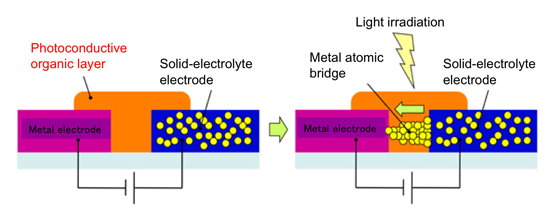 Press Release 2010
Press Release 2010
Photoassisted Formation of an Atomic Switch
This research was conducted by
Tsuyoshi Hasegawa
Tsuyoshi Hasegawa
A light-controlled atomic switch, which works as a photo-sensing memory device, has been developed by inserting a photoconductive organic layer into a gap between a metal electrode and a solid-electrolyte electrode. Light irradiation with a bias application causes metal atom precipitation from the solid-electrolyte electrode to form a metal atomic bridge.

Figure 1: Operating mechanism of a light-controlled atomic switch.
(Left) Photocurrent induced in the photoconductive organic layer by light-irradiation reduce metal cations in the solid-electrolyte electrode which precipitate as metal atoms to form a metal atomic bridge between the metal electrode and the solid-electrolyte electrode.
(Right) Operating result of light-controlled atomic switch. Light-irradiation with a bias application is needed to turn the switch on. Inserted images show a metal atomic bridge formed in the turning-on process. The photoconductive organic layer was removed to see the metal atomic bridge.

